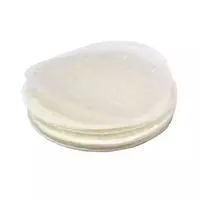Rice paper

What else is rice paper, for sure, ask you. And what does paper have to do with cooking? Yes, the most directly. Rice paper is one of the most common and quite popular components of Asian cuisine. It is used in the preparation of a large number of dishes, because rice paper is a very thinly rolled dough, which is based on rice flour, water and salt.
When ready, that is, dry, it is very fragile and brittle. Rice paper is round, transparent sheets on which it is easy to notice an interesting pattern consisting of numerous strips that are directed in different directions. These specific strips are formed during the drying process of thin rice flour dough on special straw or wooden nets.
Recipes for cooking rice paper-based dishes can be varied, but the most popular of them are still rolls. Therefore, we can safely say that this product is an excellent find for lovers of this Japanese dish and any experiments related to their preparation. It should be used in the same way as nori algae in a dried state, that is, green thin sheets. If you like hot rolls, grab rice paper, feel free to wrap the rolls around and toast them in a frying pan or deep-fried.
By the way, the Japanese use rice paper as a Russian man pancakes. However, unlike Russian pancakes, it is not impregnated with oil during manufacture, and therefore this product is considered dietary. Vegetable, fruit, fish, meat fillings or other fillers to taste can be wrapped in rice paper. As a rule, all the colors of the filler are perfectly visible through the thinnest walls of patterned sheets of rice dough, and this undoubtedly gives the finished dish an incredibly appetising appearance.
In addition, rice paper is often used as an alternative version of filo or yufka dough, because all these products are extremely thin (the difference is only in the form of flour). For example, for those who adore baklava but don't have the ability to roll out dough, rice paper is a great option. Of course, the ready-made dish tastes a little, well, only a little bit, will differ from the original, but baklava based on rice paper turns out to be no less tasty. In principle, an exceptionally sophisticated foodie is able to distinguish true baklava from its alternative.
rice paper 333 kCal
Energy value of rice paper (Ratio of proteins, fats, carbohydrates - ju):
Proteins: 5.8 g (~ 23 kCal)
Fats: 0 g (~ 0 kCal)
Carbohydrates: 77.4 g (~ 310 kCal)
Energy ratio (b | y): 7% | 0% | 93%
 Español
Español Français
Français Português
Português Русский
Русский 简体中文
简体中文 繁體中文
繁體中文 日本語
日本語 한국어
한국어 العربية
العربية Türkçe
Türkçe Қазақ
Қазақ Deutsch
Deutsch Italiano
Italiano Українська
Українська
